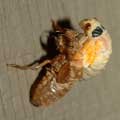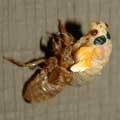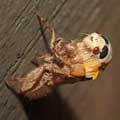 |
 |
 |
 |
| Holes | Cicada 1a | Cicada 1b | Cicada 1c |
|
Summer 2004 Herndon, VA For months now, the hysteria has been building about the impending unimaginable mass of giant bugs about to rise up from the ground and cover every square inch of, well, everything, here in Virginia. While I'm excited for the opportunity to add this to my website, I'm definitely not looking forward to the nuisance and the noise. I hear their exit will be no less unpleasant as they leave millions of carcasses piling up in the lawns, gutters, streets, sidewalks; everywhere. Crunchy! These first photos were taken on April 19 - having removed several very large juniper bushes from the front of the house, I noticed all these holes in the newly-uncovered ground beneath where the shrubs had been. The holes were about the size an index finger would make poked down into the dirt. Some had slightly raised mounds around the openings. I was curious to see what made these holes, so I started digging, and quickly realized there were lots of holes, and they were all inhabited! The first hole-dweller I uncovered quickly scooted backwards down deeper in its hole, so I dug even deeper to get it. It was a cicada! It looked ready to come out, but obviously it wasn't. They were predicting three more weeks before the Great Emergence. It wasn't till that time that I noticed these guys don't have the black markings over their eyes that they get when they're ready to molt. |
 |
 |
 |
 |
| Holes | Cicada 1a | Cicada 1b | Cicada 1c |
|
My friend Matt is a bit more daring than me and gleefully collected the larval cicadas I uncovered in my digging: |
 |
 |
| Fistful 1 | Fistful 2 |
|
He then set them up for examination on the mailbox post: |
 |
 |
 |
 |
 |
| 8 Cicadas | Cicadas 1 | Cicadas 2 | Cicadas 3 | Cicadas 4 |
|
Co-workers had been reporting them starting to show up in their yards for about a week before I finally saw the first few around my house on the evening of May 13. One woman said her neighbor's house and yard and trees and bed of ferns out front are covered in them. The following are photos taken the night of the 13th after dark with a flash - the freshly-emerged pale creatures are called "teneral" cicadas: |
 |
 |
 |
 |
 |
| Crawler | Emerging 1 | Emerging 2 | Emerging 3 | Emerging 4 |
 |
 |
 |
 |
 |
| Emerging 5 | Pale Cicada 1 | Pale Cicada 2 | Pale Cicada 3 | Getting Darker |
 |
 |
 |
||
| Getting Darker 2 | Almost Done | Almost Done 2 |
|
On a photoshoot in Arlington on May 20th, this guy flew over to pose for some shots: |
 |
 |
 |
 |
 |
| Cicada face | Cicada face 2 | Cicada face 3 | Cicada on branch | Cicada on trunk |
|
And my boss took these photos to show me the extent of his back yard invasion in Arlington: |
 |
 |
 |
 |
| Shells in the tree | Cicadas on leaves | Shells and dead cicadas | Cicadas in the bushes |
|
My friend Matt sent me these photos he took around the weekend of May 22 at his place in Springfield: |
 |
 |
 |
 |
 |
| More cicada holes | Cicada shells on leaves | Cicada shells on leaves | Cicadas on the screen | Makin' more cicadas! |
|
At the height of the frenzy, we walked to the intersection at the end of our street to measure the volume level of the screaming tree full of cicadas there - 98 decibels! That's loud enough to need hearing protection - we were thankful that tree wasn't in our yard! |
|
Around June 7th I suddenly noticed dead branch ends on a lot of trees and realized that was the damage that has been predicted due to the egg-laying activities of the female cicadas. The last photo in this row is to show the difference in genders: |
 |
 |
 |
 |
 |
| Egg holes 1 | Egg holes 2 | Egg holes 3 | Damaged trees | Genders |
|
I caught this girlie laying eggs in a branch - if you look at the photos closely, you'll notice that in the first one she has her ovipositor (long back spike behind the rear legs) in the branch. In the second one, she has moved forward and is positioning herself to make the next deposit. In the third, she's in again: |
 |
 |
 |
 |
 |
| Laying eggs 1 | Laying eggs 2 | Laying eggs 3 | Laying eggs 4 | Laying eggs 5 |
 |
 |
|||
| Closeup 1 | Closeup 2 |
|
Here are some cicadas I got to pose for some close-up portraits: |
 |
 |
 |
 |
 |
| Portrait 1 | Portrait 2 | Portrait 3 | Portrait 4 | Portrait 5 |
|
On June 18th I saw my last cicada for the season, and it had been about a week already since the noise died down and I had seen the previous one. As it turned out, my neighborhood didn't get them as badly as some, and I didn't have to put up with the piles of dead bugs. They were definitely lying all over the ground behind my office, but the cleaning crew swept up daily so we didn't get to see the full extent of carnage all at once. From the complaints I heard about stench, that was a good thing. But I have to admit, I got used to them and now I miss the little guys. See you all again in 17 years! |
|
The National Audubon Society Field Guide to North American Insects & Spiders identifies these as the Periodical Cicada, Latin name: Magicicada spp. The larval stage, called a "nymph", feeds on the sap of tree roots and takes 13 to 17 years to mature! After that, "each nymph crawls to the nearest upright support, splits its skin, and transforms to an adult. The simultaneous appearance of thousands of cicadas during a few weeks overwhelms predators, permitting the great majority to mate undisturbed." The last appearance of Brood X was 17 years ago, in 1987. I just missed them, moving to the area in August that year. |
| Home | Usage Statement |